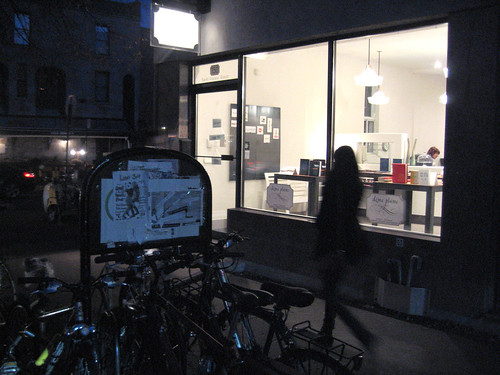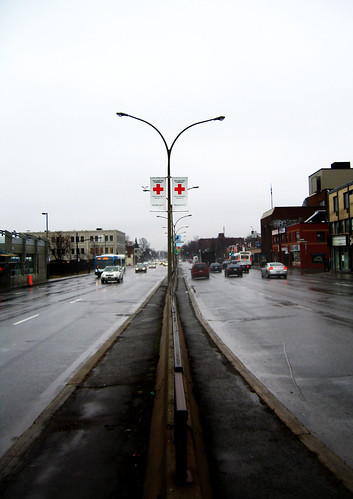
« 6 000 miles of streets which are really the front yards and the front doors where New Yorkers come out to play. »
– Janette Sadik-Khan
And they came from all walks of life, espoused all points of view, yet remained united for one cause.
They had grown tired of watching their street, their home, their front and back yard, be taken over by cars, trucks, noise, and pollution.
They were going to put an end to it, starting today.
This is what brought them together:
A café citoyen, sponsored by Car Free Mile-End and the Comité des citoyens du Mile-End; their thoughts on Saint-Viateur shared in the crowded back room of a local café.
Markets and festivals and woonerf (gesundheit!):
The crowd cast anxious glances amongst themselves, towards the presenters and through the giant panes of glass separating them from the object of their affection.
Anxious, because they know Saint-Viateur’s time is now.
« Why are we having this meeting inside here », someone exclaimed. « We should be having it outside on the street; on OUR street. »
« Amen », said the older gentlemen beside me. Amen indeed.
For the past 4 weeks, I have been reimagining Saint-Viateur and trying to see what can be done to make just one street a little better for its people.
Yes, I know:
There are so many other streets in Montréal that are actually in dire straits. If only they could be more like Saint-Viateur.
So why spend 4 weeks talking about some hipper-than-thou hangout in the Mile-End?
Because Saint-Viateur is lucky.
Lucky because it is small enough that any changes to the streetscape would avoid attracting the concerns of citizens from outside the community itself.
Lucky because it is one of the last in a series of streets in the area due for renovations.
Lucky because it is loved and is considered part of the community’s family; a family that will defend its well-being to the death.
Lucky because it is under the jurisdiction of one of the few Montréal boroughs whose council seems open to rethinking our outdated culture of urban planning.
Lucky because it is a part of my life.
And lucky because all of the above factors make it the perfect prototype for change. If we can rethink Saint-Viateur, then maybe the same will be done for Parc, for Jean-Talon, for Décarie, for Henri-Bourassa, for René-Lévesque …
The car is our maid and yet we treat it like our king. If you want this to change, make it happen.
Réimaginons Chabanel
Réimaginons Notre-Dame
Réimaginons Saint-Laurent

Replace traffic space with human space?!
Mais on n’est pas en Europe. On est à Montréal !
Denounce the propaganda. It’s time we reprogrammed our minds:
I reject the idea that only the Europeans, with their fine wine and their high art, are capable at creating better living spaces for their citizens. I dispute the notion that the European city model, where the car takes a modest place in the urban landscape, can never be achieved here in Canada.
I recognise our differences in culture, habits, and customs. I accept our contrasts in density, architecture, and design. But past this superficial diversity, we are all just human beings – one in the same. When the sun is shining and the weather is sweet, we are all outside, in the streets, in our public spaces, searching to fraternise and longing for social interaction.
- Video credits ― Streetfilms
For cities were built for families, for lovers, for children young and old. They were built to live in, not to pass through. And if the Americans have been able to grasp this concept, we can no longer accept any further excuses from our political leaders.
La Ville répondra-t-elle à cet appel lancé ?

One comment
I’ve said it before, but thank once again for this amazing series. It’s by far the best one posted yet on Spacing Montréal. I sincerely hope these articles succeed in directly or indirectly influence policy making in the city. I for one am… REPOSTING!